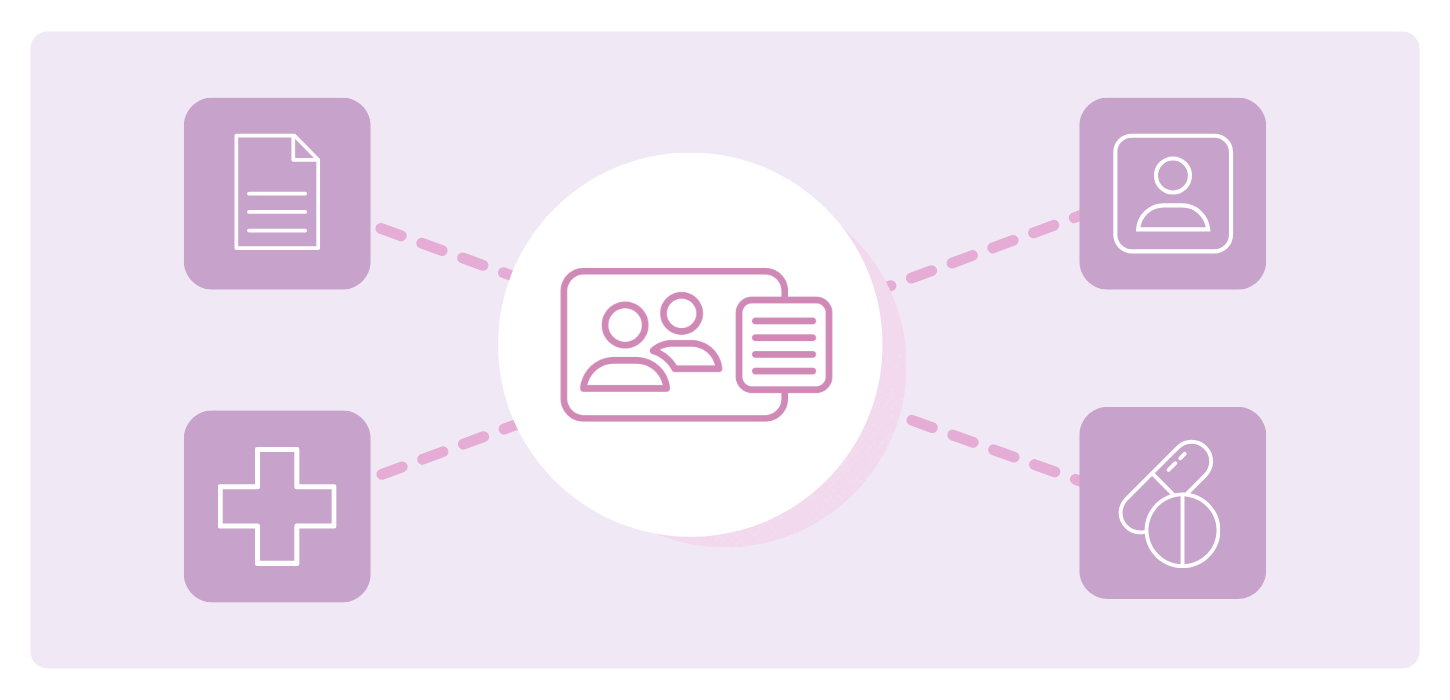At A Glance
Identity resolution unifies fragmented IDs into complete customer profiles, helping companies understand their audiences and deliver personalized, privacy-compliant experiences in a cookie-light world. With Experian’s AI-powered identity resolution solution, marketers gain the scale, accuracy, and compliance to compete while making marketing more human.In this article…
Every marketer has seen it: a customer browses reviews on a laptop, adds items to a cart on mobile, then “disappears.” In reality, they just likely switched devices or logged in with a different email. Identity resolution connects these scattered signals into a single profile so you never lose sight of the customer journey.
Identity resolution is what helps you keep track of customers who bounce around.
Connecting scattered signals into a single customer profile can help you deliver seamless experiences, meet strengthening privacy standards, turn first-party data into measurable results, and fuel better customer analytics.
See our identity resolution solution in action
What is identity resolution?
Identity resolution is the process of pulling together the different identifiers a customer uses and connecting them to a single profile. Without it, you’re left with an incomplete picture of the customer — like a cart tied to one email, an app login tied to another device, or a loyalty swipe that never links back to the same person.

Common identifiers include:
- Cookies: Short-lived browser data
- Emails: Plain-text and hashed
- Device IDs: Mobile advertising IDs (MAIDs) or app-based identifiers
- Loyalty IDs: Program numbers that tie online and offline activity
- Hashed PII: Personally identifiable information (PII) encrypted for privacy
Ultimately, identity resolution can help you recognize the same customer wherever they engage.
Why does identity resolution matter now?
Marketers face incomplete views, data silos, privacy regulations, and shrinking visibility:
- Rising consumer expectations: People want seamless, personalized journeys across touchpoints.
- Privacy-first environment: Consumer privacy legislation (like the GDPR, CCPA, GLBA, FCRA, and new state laws) makes compliance non-negotiable.
- Signal loss: The decline of cookies, MAIDs, and walled gardens are pushing brands toward first-party data.
Experian utilizes AI and machine learning to fill these gaps, predict behaviors, and connect signals across devices — providing marketers with a clear, privacy-safe view of their customers, even when traditional identifiers are missing.
In this environment, identity resolution matters because it gives marketers a way to deliver seamless, personalized customer experiences and engage audiences effectively while respecting their privacy. It’s the basis for turning consented first-party data into measurable marketing outcomes without sacrificing trust.
Why is identity resolution critical in a privacy-first world?
Even as cookies linger, marketers have already shifted their strategies to rely on first-party data, where choice and transparency are the baseline expectation. At Experian, our long history as a regulated data steward makes us a uniquely capable and trusted partner for managing modern compliance expectations. Our identity resolution solutions maximize the value of permission-based data while meeting consumer demand for privacy, personalization, and control.
Struggling with scattered customer data? Experian makes identity resolution seamless
How does identity resolution help brands?
Identity resolution turns fragmented signals into unified profiles that drive personalization, efficiency, and compliance. Here’s how it creates measurable business impact.
Creates a unified customer view
One of the biggest advantages of identity resolution is the ability to integrate data from loyalty programs, point-of-sale (POS) systems, customer relationship management (CRM) platforms, web analytics, and offline sources into a single, comprehensive profile. Experian strengthens identity resolution with AI-driven clustering models that resolve household and individual identities across billions of signals with greater accuracy.

With a clearer picture of each customer, brands see higher match rates and larger addressable audiences, which translates to more substantial reach and better return on ad spend (ROAS).
Enables better personalization
Customers constantly switch devices, update their information, and change preferences. Experian makes it easier to keep pace with these changes through frequent data enrichment and near-real-time identity resolution via Activity Feed.
Combined with our long-standing use of AI and machine learning, this approach ensures shifting behaviors are captured quickly, enabling timely personalization, and more responsive engagement.

With less delay from data to action, the result is faster response times and higher conversion rates.
Improves the customer experience
Customers notice when brands deliver relevant ads and contextual content across every channel. Consistency matters! But consistency doesn’t just happen on its own; it comes from identity resolution, which keeps the customer journey connected.

As brands maintain continuity, they build trust, strengthen engagement, and increase customer lifetime value.
Drives better marketing ROI
Not every profile is valuable. Identity resolution helps marketers identify the highest-value audiences and reduce wasted spend.

That efficiency leads to lower CPA and a higher overall ROI across campaigns.
The power of modeling from a stronger foundation
When you have a unified customer view, your models are built on better data. That means you can find more people who look like your best customers, build more responsive audience segments, and target with greater accuracy. This foundation can lead to better spending, more relevant campaigns, and a higher ROI.
Maintains privacy compliance
With GLBA/FCRA-grade standards and consumer choice mechanisms like opt-outs and data correction, you can protect your brand while maintaining personalization — without compromising legal or ethical safeguards.

What are some identity resolution use cases and examples?
Every industry faces its own unique identity challenges, but identity resolution is the common thread that turns scattered data into connected experiences. Let’s break down how companies in different verticals are putting it to work (and the kinds of results they’re seeing).
Retail and e-commerce
Shoppers bounce between websites, carts, and checkout lines, leaving behind scattered signals in the process. In retail, identity resolution bridges the gap between online and in-store experiences by matching online carts with loyalty swipes or connecting connected TV (CTV) exposure to in-store sales. This means fewer silos, better targeting, and more personalized offers wherever people shop.

Our 2025 Digital trends and predictions report calls out that omnichannel experiences aren’t optional anymore. With CTV and social dominating spend, brands need identity resolution to cut through silos and build a complete view of customer behavior.
Financial services
In financial services, identity resolution makes it possible to deliver personalized, compliant offers like refinancing options for likely mortgage switchers or the right rewards card for frequent spenders.
Our partnership with FMCG Direct to create Consumer Financial Insights® and Financial Personalities® segments helps banks, insurers, and lenders understand behaviors — such as credit card use, deposit balances, and investment habits — without exposing sensitive details.
Read more below about how our financial audiences enable privacy-safe personalization.
Travel and hospitality
Travel decisions aren’t always planned out in advance. Many bookings happen spur-of-the-moment, which is why real-time identity resolution is so powerful; it keeps the journey seamless when travelers jump from phone to laptop to tablet and presents relevant offers right as decisions are being made.
Windstar Cruises put this information into action with Experian’s identity graph to connect digital interactions with actual bookings, which drove 6,500+ reservations and $20 million in revenue.
Media and TV
Viewers tend to hop around between linear TV, streaming apps, and social feeds. And without identity resolution, every screen looks like a different person. Marketers can accurately plan, activate, and measure campaigns by unifying viewing behaviors into one ID with Experian’s AI-powered identity graph.

Optimum Media tackled its multiscreen challenge by partnering with Experian for identity solutions. Layering our audience insights and our AI-driven Digital Graph onto their subscriber data, they were able to connect the dots across channels, reach the right households, and measure results instead of just impressions. In the end, they finally got a clear view of what works across every screen.
Curious how identity resolution can power your customer analytics? We can walk you through it.
Healthcare and pharma
Healthcare marketers can’t afford slip-ups with HIPAA regulations. Identity resolution makes it possible to engage the right patients and providers with de-identified audiences rather than third-party cookies.

At Experian, AI and machine learning have always been part of how we power identity resolution. In healthcare, that means using AI-enhanced modeling to connect de-identified clinical and claims data with lifestyle insights. The result is a more comprehensive picture of the patient journey that helps close care gaps, reduce wasted spending, and improve outcomes.
By working with partners like Komodo, PurpleLab, and Health Union, we make it possible to activate campaigns at scale that boost engagement and adherence while keeping patient privacy front and center:
- Komodo Health enriches our identity graph with insights from millions of de-identified patient journeys plus lifestyle data, giving brands a fuller view of where care gaps exist and how to close them.
- PurpleLab connects real-world clinical and claims data to Experian’s platform, letting advertisers activate HIPAA-compliant audiences across CTV, mobile, and social with the ability to measure real outcomes like prescription lift and provider engagement.
- Health Union contributes a data set built from 50 million+ patient IDs and 44 billion+ patient-reported data points. Combined with our identity and modeling capabilities, this expands match rates and unlocks up to 76% net-new reach, so campaigns reach patients and caregivers in critical health moments.
As a result, healthcare brands can launch campaigns that are privacy-first, highly targeted, and proven to drive meaningful impact.
Audio
People use audio while commuting, working out, and even folding laundry. It can be one of the hardest channels to track because of how frequently listeners switch between apps, stations, and devices.

Experian’s identity resolution partnerships with Audacy and DAX change the game:
- Audacy helps tie scattered listening into a single view, so advertisers can follow audiences across devices and keep ads relevant in the moment.
- DAX pairs Experian’s 2,400+ syndicated audiences with its audio network, enabling brands to target precisely and launch impactful campaigns at scale.
These partnerships turn audio into an accurate channel where ads feel personal, privacy-safe, and measurable.
Gaming
Gamers don’t stick to one platform. Player data gets scattered across mobile, console, and PC, so it’s tough to keep track of individuals. Experian helps stitch those signals together so publishers can finally see the whole picture, personalize gameplay, and keep players coming back.
With enriched profiles, publishers can deliver offers that resonate and unlock fresh revenue by packaging high-value gaming audiences for advertisers outside the industry.
Unity, a leading gaming platform, is tapping into Experian’s syndicated audiences to gain player insights and help advertisers reach gamers across mobile, web, and CTV. For global publishers, unifying player data with Experian has driven higher engagement and stronger ad ROI.
How should I evaluate identity resolution providers?
When choosing an identity resolution partner, look for:
- Data scale and quality: The value of identity resolution depends on how complete and accurate the underlying data is. The right provider should bring together a wide range of identifiers from online and offline sources, maintaining high accuracy so your customer profiles are broad and reliable.
- Match accuracy and recency: The best partners also refresh their data regularly and can blend deterministic (exact, one-to-one matches) with probabilistic (pattern-based matches) methods. That way, you get the accuracy of “this email is definitely that customer” with the reach of “this device likely belongs to the same person.”
- Privacy and compliance readiness: Compliance can’t be an afterthought. Your identity partner should be ready for GLBA, FCRA, GDPR, CCPA, and the latest state-level rules with built-in tools for opt-outs, corrections, and deletions.
- Integration flexibility: A good provider fits into your world, not the other way around. Look for pre-built integrations with your customer data platform (CDP), demand-side platform (DSP), or marketing tech (MarTech) stack so you can get up and running without the heavy IT lift.
- Data analytics capabilities: You need proof that identity resolution drives ROI. Look for closed-loop measurement that ties unified IDs directly to campaign performance, so you can see what’s working and optimize with confidence.
How Experian enables enterprise-grade identity resolution
Experian delivers identity resolution at the scale, accuracy, and compliance required by the world’s largest enterprises. Our solutions are:
- Built on trust: Backed by 40+ years as a regulated data steward and rated #1 in data accuracy by Truthset, so you can act with confidence.
- Powered by our proprietary AI-enhanced identity graph: Combining breadth, accuracy, and recency across four billion identifiers, continuously refined by machine learning for maximum accuracy.
- Seamlessly connected: Pre-built data integration with leading CDPs, DSPs, and MarTech platforms for faster time to value.
- Always up to date: Frequent enrichment and near-real-time identity resolution through Activity Feed for timely personalization and more responsive customer engagement.
- Privacy-first by design: Compliance with GLBA, FCRA, and emerging state regulations baked in at every step, supported by rigorous partner vetting.
The bottom line
Identity resolution turns fragmented signals into connected, measurable, and compliant experiences. From retail to gaming, brands using it see stronger personalization, engagement, and ROI.
With Experian, you get the data, trust, and responsible AI innovation to make identity resolution work across every channel. Our approach uses AI to connect identities, predict behaviors, and deliver personalization that balances privacy with performance. If you’re ready to turn fragmented data into growth, now’s the time to start.
The world’s leading brands trust us to power identity resolution at scale. See how we can do the same for you.
Identity resolution FAQs
Deterministic uses exact identifiers (like an email) for accuracy, while probabilistic uses signals and algorithms to expand reach. Best-in-class providers usually combine both.
Identity resolution helps with personalization by unifying scattered signals into one profile. It reduces wasted spend and increases match rates, which means bigger addressable audiences and higher ROAS.
Yes. With first-party data and hashed PII, brands can still maintain addressability and personalization.
Retail, finance, travel, media, gaming, and audio all use identity resolution to personalize, attribute sales, and improve efficiency.
A customer data platform unifies the data you already own. Meanwhile, we add depth, scale, and higher match rates by layering in our identity graph and data enrichment.
Yes. Experian is GLBA/FCRA compliant, GDPR/CCPA ready, and supports consumer opt-outs and corrections to ensure responsible personalization.
Latest posts

Suppose you're watching your favorite TV show, and an ad suddenly catches your attention. It urges you to take immediate action, whether to call a number, visit a website, or text a keyword like ‘DETAILS’ to a specific number for more information. This is direct response television (DRTV), a powerful form of advertising available on all TV types — including live, cable, and streaming — that directly connects brands with consumers to drive immediate engagement and measurable results. The goal of DRTV marketing is simple: convert viewers into customers quickly and measurably by asking them to do something in real time. Every DRTV ad is carefully designed to drive quick conversions with a clear, direct path from interest to action. This makes it an essential tool for marketers who need to measure their return on investment (ROI) for TV and see instantaneous results. Key benefits of DRTV marketing Unlike traditional TV ads that build long-term brand awareness, DRTV campaigns are focused on driving instant results and are surprisingly effective at doing it. Here are a few benefits of DRTV and why it’s a powerful tool for marketers in a digitized world. Immediate customer engagement One of the biggest advantages of DRTV is its ability to engage customers right off the bat. DRTV grabs attention and motivates people to act now, whether with a phone number on the screen, a QR code to scan, or a limited-time offer, often with compelling incentives. Measurable ROI DRTV is designed to deliver precise, trackable results. Because the ads encourage specific actions — like visiting a website or calling a phone number — it’s easy to see what’s working and what’s not. Marketers can measure everything from sales to lead generation, which guides them in refining their strategies for even better results. Pairing DRTV with digital tools, like web analytics or CRM systems, can provide even deeper campaign performance insights. Broad reach Even in the streaming age, live TV and cable still attract millions of viewers, which makes DRTV excellent for brands needing to expand their reach. Marketers can even tailor DRTV ads to specific audiences by choosing the best time slots on the proper channels. Whether you’re targeting parents watching morning news or sports fans tuning into big games, you’ll know you’re connecting with the right people at optimal times. Types of DRTV ads DRTV advertising offers several formats, each suited to different audiences, budgets, and goals, whether you’re introducing a new product or driving traffic to your website. Infomercials Infomercials are the classic, long-form DRTV ads that most people associate with the term. These ads typically run for 15-30 minutes and go into detail on product benefits and features. They often include demonstrations and special offers to educate and engage viewers with urgent, limited-time deals. Think of the iconic “But wait, there’s more!” ads used to sell everyday items ranging from household cleaners to exercise equipment. Short-form ads Short-form DRTV ads are 30-second to 2-minute ads that get straight to the point with a single message or offer and a clear call-to-action (CTA) to encourage immediate engagement. Short-form ads are ideal for quick bursts of information, like promoting a flash sale or highlighting a new product. A 60-second ad showcasing a new mobile app might feature a quick walkthrough of its features, followed by a QR code or website URL to download it instantly. Product demos Some DRTV ads focus exclusively on demonstrating how a product works in real-life scenarios. These ads are great for showing off unique features or solving familiar pain points that make the product feel essential. A cookware brand might show how its nonstick pans make cooking and cleanup a breeze while including a CTA to “order now and get a free bonus spatula!” Testimonials Testimonials from real customers or experts are a great way to build trust and credibility. Hearing someone’s success story or endorsement of a product or service can help viewers feel confident about their purchase decision. A skincare brand, for example, might air a two-minute ad of a dermatologist explaining the science behind the product, along with five-star reviews from satisfied users. Call-in contests or limited-time offers This type of DRTV ad creates urgency by promoting a special offer or giveaway. Viewers might have to call a number or visit a website within a specific timeframe to claim the deal. For example, travel agencies sometimes air ads offering free vacations or planning kits to the first 100 callers, which helps them generate immediate leads. Hybrid ads with digital integration Many modern DRTV campaigns blend traditional TV with digital tools, like QR codes, social media hashtags, or links to custom landing pages. These hybrid ads meet viewers wherever they are. A fitness program might air a short-form ad with a QR code linking to their free app trial, making it easy for viewers to instantly engage. Success tips for DRTV advertising Creating a successful direct response TV campaign centers on messaging that resonates with the right audience, inspires action, and delivers measurable results. Here are some essential tips for a winning DRTV strategy. Strong CTA Every DRTV ad should include a compelling, straightforward CTA that motivates viewers to act immediately. Whatever it is, your CTA should be easy to understand and time-sensitive to create urgency, such as, “Claim this limited-time offer in the next 30 minutes!” Multi-channel integration Direct response TV works best when part of a broad multi-channel strategy, so you should make sure your campaign integrates well with digital channels. This can reinforce your message, help consumers engage across platforms, and drive better results. Audience targeting Precise audience targeting is critical to DRTV campaign success. Experian’s advanced TV audiences, developed with the Advertising Research Foundation (ARF), help you connect with the right viewers to drive immediate action. These syndicated audiences are now available on FreeWheel, the TV advertising industry’s global tech platform. With over 2,400 ready-to-use audience segments, Experian enables you to target specific groups, such as: TV viewership audiences: Target households based on viewing habits and preferred devices. In-market car buyers: Reach consumers actively searching for their next vehicle, which is ideal for driving sales. Holiday shoppers: Engage gift-givers, deal-seekers, and travelers during peak shopping seasons. New TV audiences released in August 2024 In addition to these, our August 2024 release introduced several updates that further refine Experian’s targeting capabilities. Some of the audience updates in this release included: New retail transaction audiences: These segments offer insights into categories like children’s products, parenting, hobbies and crafts, science and nature, and sports and fitness. With high spending and frequent purchase behaviors, these audiences provide a deeper understanding of consumer preferences. Notable segments include: Sports and fitness high spenders Children’s product high spenders Science and nature high spenders Updated TV audiences: New and refreshed TV segments now reflect the viewing habits of today’s consumers for accurate insights and targeting. Examples of newly added segments include: Free and paid ad-supported streaming TV subscribers Satellite service subscribers Cable and streaming TV service subscribers With these advanced targeting capabilities, your DRTV campaigns can be more effective and resonant with viewers most likely to respond for maximum ROI and engagement. Effective planning A strong DRTV campaign starts with defining your objectives, budgeting effectively, and identifying the right media mix. Understanding where your audience spends their time — prime-time TV or niche cable channels — will get you the most value from your DRTV investment. Real-time tracking Tracking your DRTV campaign’s performance in real time is critical for success. Tools that provide immediate insights into viewer responses, website visits, or call volumes allow you to identify what’s working and pivot quickly if needed. Measuring success Measuring success against key performance indicators (KPIs) like conversion rates, ROI, or cost-per-acquisition (CPA) is an excellent way to know if your DRTV campaign is delivering results. Experian’s advanced data solutions make tracking and analyzing campaign performance easier, so you can make data-informed decisions and deliver precise results to stakeholders. Continuous optimization DRTV marketing is an ongoing effort. Use the insights from real-time tracking and performance measurement to refine your strategy. Optimization keeps your campaign relevant and effective, whether you need to tweak your CTA, adjust your audience targeting, or test new creative formats. How DRTV relates to advanced TV and connected TV While DRTV has historically focused on immediate viewer actions via traditional linear TV, it’s found new relevance within advanced TV and connected TV (CTV) ecosystems. These modern formats expand the measurable, action-driven qualities of DRTV while incorporating the precise targeting and personalized storytelling made possible by digital technologies. DRTV and advanced TV Advanced TV enhances DRTV by enabling addressable advertising, which helps marketers deliver ads to specific households based on behavioral or demographic data. For instance, using tools like Experian’s Graph, advertisers can integrate data sets across multiple sources to refine audience segmentation and tailor messages to individual households. Advanced TV also supports cross-channel consistency to provide a unified customer experience whether the viewer engages with linear TV, streaming services, or other devices. Additionally, programmatic ad buying plays a role in automating the ad-buying process. This helps advertisers optimize their bids and placements and get DRTV campaigns in front of the right audience at the right time, which maximizes cost-efficiency across both traditional and digital channels. DRTV and CTV CTV has a high rate of logged-in, authenticated viewers and provides a lot of helpful first-party data. This allows for hyper-precise audience targeting, cross-device attribution, and an ability to link ad exposure to conversions — even when purchases occur on non-CTV devices. Universal IDs like UID2 further strengthen these capabilities by creating consistent and privacy-respecting user identities across platforms. Experian’s TV partnerships Through partnerships with leading CTV players like Madhive, Samsung, Disney/Hulu, and others, Experian’s identity solutions integrate seamlessly to support well-timed, personalized ads across major streaming platforms. These integrations, powered by our Digital and Offline Graphs, offer a complete view of audiences to enable more controlled, effective activation across mediums, including free ad-supported streaming television (FAST) channels. Using Experian’s advanced data and identity tools, advertisers can tap into the full potential of DRTV strategies within advanced TV and CTV to make campaigns more actionable, efficient, and impactful. The future of DRTV So, what is DRTV going to look like in the future? With the integration of digital and television platforms, DRTV is becoming more targeted, interactive, and personalized. This shift creates new opportunities for advertisers to drive conversions. Here are some key advancements that will continue to shape the future of DRTV: Addressable TV: Advertisers can deliver targeted ads to specific households based on demographic and behavioral data. It uses data from smart TVs, streaming devices, and third-party data providers to enable highly relevant ads based on the interests of individual viewers. Interactive TV ads: Interactive TV ads enable viewers to engage directly with the content through their remote control or mobile devices. Users can click on a product for more information or make purchases without leaving the TV screen and immediately convert. Authenticated audiences: With CTV and AI technology, advertisers can use first-party data from authenticated users to improve targeting, measurement, and campaign performance. Advertisers can create a more cohesive and personalized experience by linking viewers across multiple devices, which improves ad effectiveness and attribution. Branded apps with saved information: Branded apps that store payment and personal information streamline the direct response process. These apps reduce purchase journey friction and allow quicker conversions, as viewers can complete transactions with fewer steps. QR codes replacing URLs: QR codes are becoming a popular alternative to traditional URLs in DRTV ads. These codes provide a quick, convenient way for viewers to visit a website, access a product page, or act on a CTA simply by scanning the code with their phone. Better targeting algorithms: Advancements in targeting algorithms allow advertisers to serve more personalized and relevant ads. These algorithms help ads reach the right audience at the right time, which can increase engagement and conversion rates. These innovations offer advertisers more tools to connect with audiences in a personalized, interactive, and measurable way. Connect with Experian’s TV experts Experian can help you achieve the full potential of your direct response TV advertising efforts with our advanced tools, precise audience targeting, and strong industry partnerships. We help brands create impactful DRTV campaigns that drive real-time engagement, audience connection, and measurable results, whether for traditional, advanced, or CTV. Reach out today to work with us on your DRTV efforts and achieve better ROI, or explore how our expertise can transform your TV advertising campaigns. Connect with our TV experts Contact us Latest posts

The stakes are high when it comes to advertising during football’s biggest games as the cost of advertising continues to rise, with the average 30-second TV ad during the 2023-24 Sunday Night Football season priced at $882K. With record viewership at the College Football Playoff and the Super Bowl drawing in 123.7 million average viewers, the largest TV audience on record, it's no surprise that brands are willing to pay those prices since football games are prime time for reaching engaged audiences. In fact, an estimated 51% of viewers search for an ad they saw during the game, underscoring the potential of second-screen engagement to amplify campaign impact. Whether you advertise on TV during these games or not, brands are exploring how they can use football season to drive a deeper connection to their audience. To do this, brands need data driven strategies. In this blog post, we’ll reveal audience segments designed for you to craft tailored marketing strategies that resonate with football fans in the stands and on the couch. You can find the complete audience segment name in the appendix. Make a game-winning play with Experian Audiences With playoff season fast approaching, it’s the perfect time to go on the offensive and target football fans. Utilize Experian’s syndicated audiences to ensure your marketing messages resonate with fans when they're the most engaged. Experian’s 2,400+ syndicated audiences are available directly on over 30 leading television, social, programmatic advertising platforms, and directly within Audigent for activation within private marketplaces (PMPs). Reach consumers based on who they are, where they live, and their household makeup. Experian ranked #1 in accuracy by Truthset for key demographic attributes. Access to unique audiences through Experian’s Partner Audiences available on Experian’s data marketplace, within Audigent for activation in PMPs and directly on platforms like DirectTV, Dish, Magnite, OpenAP, and The Trade Desk. Four football audience categories to add to your advertising lineup Football fans come in all shapes, sizes, and viewing habits. From dedicated supporters to casual viewers, targeting the right audience can make or break your campaign. Here are four football audience categories you can target: Sports enthusiasts College football fans 21+ audiences TV viewers Let’s huddle up and break down the audience segments within each category. Whether it’s tailgating, tuning in, or cheering from the stands, these insights will get your campaign into the end zone. Sports enthusiasts Whether they’re following their favorite teams, attending games in person, or watching professional sports events on TV, football fans are deeply engaged, making them an ideal target for advertisers looking to score big. Here are five audiences to target: NFL Enthusiasts Football (FLA/Fair Lending Friendly)1 Sports Enthusiasts NFL Stadium Visitors Professionals Sports Event College football fans College football fans bring unmatched passion and loyalty, with bowl games during the 2023 season drawing on average of 4.6 million viewers across 40 total games—a 5% increase year-over-year. From students to alumni, these fans represent an invaluable opportunity for advertisers to connect with a deeply invested audience. Here are four audiences to target to connect with passionate college football fans: College Football Stadium Visitors College Football Bowls College Students College Sports Venues 21+ audiences With 84% of U.S adults reporting that they drink alcohol while watching football on TV, targeting 21+ audiences during game season is a winning play. Whether they’re cracking open a cold one at a tailgate, hosting a game-day party, or relaxing on the couch, these audiences represent a key audience for brands looking to tap into football culture. Here are four audiences that you can target this post season: Imported Light Beer Enthusiasts Domestic/Imported Beer High-end Spirit Drinkers Discretionary spend: Alcohol and wine $331 – $726 These audiences can help you serve up campaigns that pour directly into the heart of football fandom. TV viewers Football games attract some of the most engaged and diverse TV audiences, with 85% of sports fans preferring to watch live sports on TV rather than in-person. Notably, for the first time, viewers aged 18 to 49 spent the majority of their sports viewing time (54%) via streaming. This shift highlights the immense opportunity for advertisers to connect with highly attentive viewers tuned into every play. Here are seven audiences that you can use to create a game-winning strategy to reach engaged TV watching football fans: Cable Satellite or Streaming Network Subscribers Streaming Video: High Spenders Cord Cutters Cable and Streaming TV Service Subscribers Paid TV High Spenders Screen Size – Large Co-Watchers Whether they're catching the action on a large TV screen or streaming from their phone, these audiences will help you craft campaigns that deliver results with highly engaged viewers. Score big with Experian this postseason As some of football’s biggest games approach, it’s time to huddle up and connect with consumers who live for the thrill of the game. Whether they’re tuning in to cheer for their favorite teams, tailgating with friends, or enjoying the game-day experience from home, Experian Marketing Data provides the playbook to score big with targeting, enrichment, and activation. With Experian’s data-driven insights, you can turn every opportunity into a game-winning play! Need a custom audience? Reach out to our audience team and we can help you build and activate an Experian audience on the platform of your choice. Additionally, work with Experian’s network of data providers to build audiences and send to an Audigent PMP for activation. Connect with our audience team Connect with us You can activate our syndicated audiences on-the-shelf of most major platforms. For a full list of Experian’s syndicated audiences and activation destinations, download our syndicated audiences guide. Explore our other seasonal audiences that you can activate today. View now 1 “Fair Lending Friendly” indicates data fields that Experian has made available without use of certain demographic attributes that may increase the likelihood of discriminatory practices prohibited by the Fair Housing Act (“FHA”) and Equal Credit Opportunity Act (“ECOA”). These excluded attributes include, but may not be limited to, race, color, religion, national origin, sex, marital status, age, disability, handicap, family status, ancestry, sexual orientation, unfavorable military discharge, and gender. Experian’s provision of Fair Lending Friendly indicators does not constitute legal advice or otherwise assures your compliance with the FHA, ECOA, or any other applicable laws. Clients should seek legal advice with respect to your use of data in connection with lending decisions or application and compliance with applicable laws. Appendix Sports enthusiasts Lifestyle and Interests (Affinity) > Activities and Entertainment > NFL Enthusiasts Lifestyle and Interests (Affinity) > Sports and Recreation > Sports Enthusiast Mobile Location Models > Visits > NFL Stadium Visitors Lifestyle and Interests (Affinity) > Sports > Football (FLA / Fair Lending Friendly)2 Travel Intent > Activities > Professional Sports Event College sports fans Mobile Location Models > Visits > University Stadium College Football Visitor Lifestyle and Interests (Affinity) > Sports > College Football Bowls Mobile Location Models > Visits > College Students Mobile Location Models > Visits > College Sport Venues 21+ audiences Lifestyle and Interests (Affinity) > Activities and Entertainment > Imported Light Beer Enthusiasts Lifestyle and Interests (Affinity) > In-Market > Domestic/Imported Beer Lifestyle and Interests (Affinity) > Retail > High-end Spirit Drinkers Financial – Analytics IQ > Discretionary Spend > Alcohol and Wine: $331-$726 TV viewers Television (TV) > Household/Family Viewing > Cable Satellite or Streaming Network Subscribers Retail Shoppers: Purchase Based > Entertainment > Streaming/Video/Audio/CTV/Cable TV: Streaming Video: High Spenders Television (TV) > Household/Family Viewing > Cord Cutters Television (TV) > Household/Family Viewing > Cable and Streaming Service Subscribers Television (TV) > TV Enthusiasts > Paid TV High Spenders Television (TV) > Viewing Device Type > Screen Size – Large Television (TV) > Household/Family Viewing > Co-Watchers Latest posts

As marketers face growing fragmentation and signal loss, Experian has launched a powerful new solution: a data marketplace that brings addressability, interoperability, and identity resolution into one activation-ready platform. Download the overview to see how our data marketplace connects high-quality identity to scalable activation across all screens. Download the overview The data you need to reach real people across every channel Today’s marketers are trying to connect with real people, not just cookies, devices, or IDs, across more channels than ever. But with so many signals disappearing, that’s getting harder to do. That’s where Experian’s data marketplace comes in. Our data marketplace is built on our best-in-class identity graph, which includes 126 million U.S. households, 250 million individuals, and 4 billion+ active digital IDs. Experian connects the entire ecosystem — TV operators, programmers, supply-side platforms (SSPs), demand-side platforms (DSPs), and brands — with activation-ready audiences that drive measurable performance. Buyers can access data from retail, CPG, healthcare, B2B, location intelligence, and more. Because we start with verified offline data, our audiences are grounded in real-world accuracy, not just digital assumptions. That means when you activate through our marketplace, you can: Reach more of the right people Stay accurate at scale Keep addressability high even as the ecosystem shifts Whether you're running a campaign on CTV, mobile, or display, we help you show up in the right place, to the right person, at the right time. Related reading Four CTV advertising misconceptions marketers need to drop Tap into premium data from top partners like: Alliant, Attain, Circana, Dun & Bradstreet, and more. "Experian has been a longstanding partner of DISH Media, and we’re excited to be an early adopter of their marketplace which leverages the foundation of their identity solutions to ensure maximum cross-channel reach as we look to expand the breadth and depth of data we use for addressable TV."Kemal Bokhari, Head of Data, Measurement & Analytics Want a quick overview of Experian's data marketplace? Watch our video for a quick overview of how Experian's data marketplace works. Read the article here How it works: Benefits for buyers, sellers, and platforms Our data marketplace is built to support high-performance media strategies, helping partners activate and scale faster. Here’s how it delivers: Enhances addressability and match rates All audiences delivered from our marketplace benefit from our best-in-class offline and digital identity graphs, which ensure addressability across all channels like display, mobile, and CTV. Unlike other data marketplaces, Experian ensures all identifiers associated with an audience have been active and are targetable, improving the accuracy of audience planning. Simplifies audience planning and distribution for TV Operators TV operators can build custom audiences matched directly to their subscriber footprint and distribute them across all advanced TV channels (data-driven linear, addressable, digital, and CTV) for maximum impact. Reintroduces choice within the data marketplace ecosystem With the departure of Oracle’s advertising business, the optionality for buyers and sellers to connect with third-party data has become increasingly limited. With Experian's data marketplace, we’re excited to offer a new solution to the market that ensures data-driven targeting can continue to take place at scale. Reduces activation costs Experian’s data marketplace offers transparent, pass-through pricing with no additional access fees, enabling partners to maximize their earnings while reducing costs. Expands audience diversity and scale Platforms can access a broad range of audiences across top verticals from our partner audiences, which can be combined with 2,400+ Experian Audiences. This offers the flexibility, reach, and scale necessary to effectively execute advertising campaigns. “Circana and Experian have enjoyed a deep partnership for over a decade. We are exceedingly excited to extend our partnership and be an early adopter and launch partner of the Experian data marketplace. This additional capability will enable the ecosystem to more easily access Circana’s purchase-based CPG and General Merchandise (for example Consumer Electronics, Toys, Beauty, Apparel etc.) audience segments to drive performance outcomes across all media channels.”Patty Altman, President, Global Solutions Want to learn more about our data partners? Q&A with Attain Q&A with Circana Q&A with Webbula “Capturing the attention of target audiences across channels is critical for marketers navigating an increasingly connected digital world. We are excited to be an exclusive provider of B2B solutions within Experian’s marketplace, helping brands and media agencies to accelerate their reach, addressability and targeting capabilities across TV, mobile and connected TV channels.” Georgina Bankier, VP of Platform Partnerships How Yieldmo drove in-store traffic for an athletic retailer with Experian's data marketplace Yieldmo, a leading SSP known for its AI-powered creative formats and privacy-forward inventory, partnered with Experian to support an athletic retailer’s campaign focused on driving in-store traffic — particularly during key sales windows. By using Experian’s data marketplace, Yieldmo built a self-serve targeting strategy combining Experian Audiences and high-performing partner segments (e.g., Alliant, Circana, Webbula, and Sports Innovation Lab). They were able to: Quickly identify in-store and conquest segments Easily combine first- and third-party audiences Improve match rates and cross-channel addressability Deliver measurable foot traffic lift “Experian’s data marketplace fills a critical gap, letting us quickly search by brand, build smarter conquest segments, and activate audiences fast. The platform is flexible and the support is hands-on and reliable.”Abby Littlejohn, Director of Sales Planning The result? Faster setup, more tailored audiences, and stronger in-store outcomes all while reducing manual work. Download the full case study Learn more about our solutions for SSPs Ready to activate? Better connections start with Experian's data marketplace Experian’s data marketplace, easily accessible from our Audience Engine platform, brings unparalleled addressability, enabling our clients to reach more relevant consumers and increase revenue. Talk to our team if you’re interested in learning more about our new data marketplace or becoming an active buyer or seller, or download our overview to learn more. FAQs What is Experian’s data marketplace? Experian’s data marketplace is a centralized, activation-ready platform that allows TV operators, programmers, supply partners, and demand platforms to access and activate high-quality, privacy-compliant audiences across CTV, mobile, and display. It supports both first-party onboarding and third-party audience activation. Who is the Experian data marketplace designed for? The Experian data marketplace is built for TV operators, programmers, supply partners, and demand platforms looking to improve audience targeting, match rates, and addressability across fragmented digital environments. What types of audiences are available in the Experian data marketplace? The Experian data marketplace offers a mix of Experian proprietary audiences and third-party data partner segments across verticals like retail, CPG, B2B, healthcare, financial services, and location intelligence. Users can activate over 2,400+ Experian Audiences and premium partner segments from providers like Alliant, Attain, Circana, Dun & Bradstreet, Webbula, and more. How does Experian ensure addressability and match rate performance? Experian’s data marketplace is powered by our identity graphs which are rooted in verified offline data, spanning 126 million U.S. households, 250 million individuals, and over 4 billion active digital identifiers. This foundation ensures that audiences are accurate, actively targetable, and optimized for high match rates across CTV, mobile, and display platforms. Is Experian’s data marketplace privacy-compliant? Yes. All data in the Experian data marketplace is subject to Experian’s rigorous partner review process to ensure compliance with federal, state, and local consumer privacy regulations. Privacy and data stewardship are foundational to our data marketplace’s design. What makes Experian’s data marketplace different from other data marketplaces? Experian’s data marketplace stands out for its focus on audience accuracy, partner integration, privacy compliance, and deep identity expertise. Here’s how we’re different: – Accurate audience planning: Unlike many other marketplaces, Experian ensures that all identifiers tied to an audience are verified as active and targetable — improving match rates and reducing waste. – Seamless partner audience integration: In one platform, you can activate Experian Audiences alongside premium segments from our growing partner network — including Alliant, Attain, Circana, and more. – Privacy and compliance built in: Every partner and audience goes through Experian’s rigorous review process to meet federal, state, and local consumer privacy laws — so you can activate with confidence. – Trusted identity foundation: Experian’s identity graph is grounded in decades of offline data expertise, powering more reliable targeting and activation than marketplaces built solely on digital signals. Where can I learn more or get started? You can download the overview to explore the capabilities, or contact our team to become an active buyer or seller. The Experian data marketplace is available through Experian’s Audience Engine platform. Latest posts